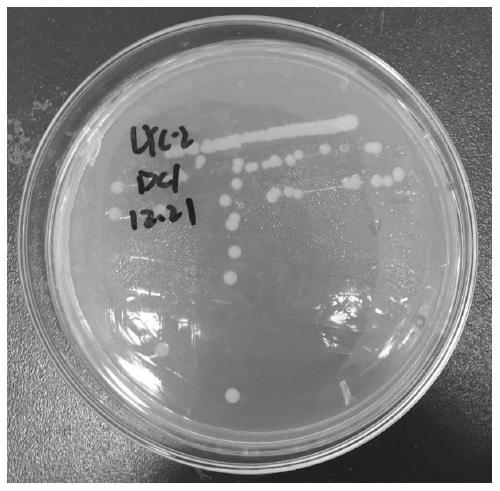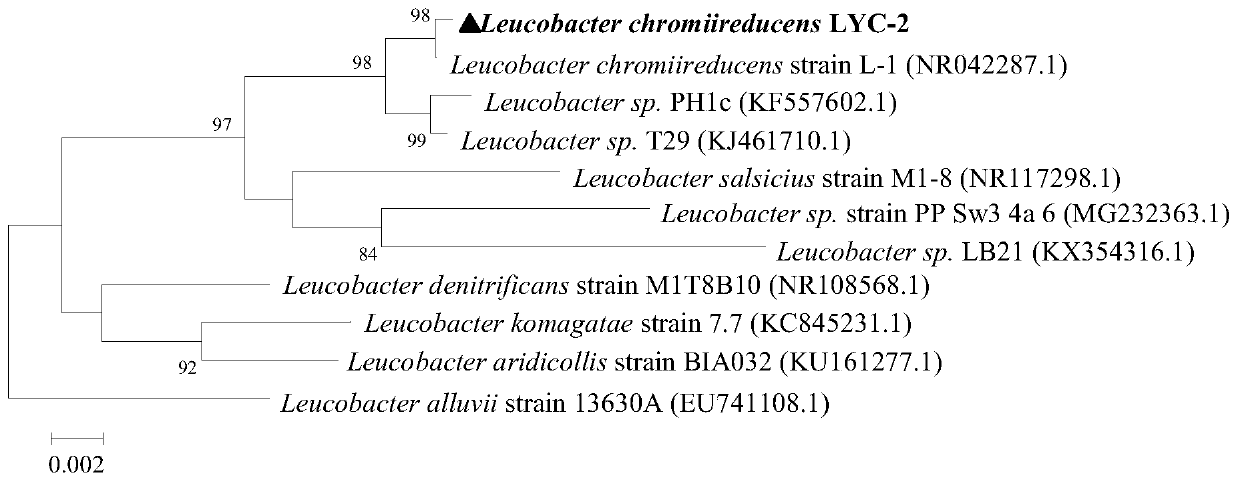Leucobacter chromiireducens and application thereof in reducing hexavalent chromium
A technology of bacillus albicans and hexavalent chromium, applied in the field of environmental microorganisms, can solve the problem of low tolerance to hexavalent chromium, and achieve the effect of wide application range
- Summary
- Abstract
- Description
- Claims
- Application Information
AI Technical Summary
Problems solved by technology
Method used
Image
Examples
Embodiment 1
[0032] Example 1: Isolation and Identification of Super Hexavalent Chromium-tolerant Bacteria
[0033] Step 1: Bacteria Isolation
[0034] Retrieve the wastewater sample from the wastewater outlet of the tannery, enrich and cultivate it, separate the effective strains on the plate, pick the obligate strains for pure culture, and gradually increase the concentration of hexavalent chromium to obtain Bacteria with strong tolerance to hexavalent chromium.
[0035] Step 2: Colony Morphological Observation
[0036] The strain Leucobacter chromiireducens LYC-2 was streaked and separated on the LB plate, and the morphological characteristics of the colony of the strain on the solid plate were observed after 48 hours: the colony was round, milky yellow, smooth, and the diameter of the colony was 0.5-1.0mm ( figure 1 ).
[0037] Step 3: Gram staining of bacteria
[0038] The bacterial body was sliced, and Gram staining was carried out, and the Gram staining of the bacterial strain w...
Embodiment 2
[0057] The hexavalent chromium tolerance of embodiment 2 bacteria
[0058] Activation of the first step bacteria
[0059] Pick a single colony from the LYC-2 plate and culture it overnight in 20 mL of LB liquid medium, and then transfer it to 100 mL of LB liquid medium for expansion.
[0060] Hexavalent chromium tolerance of bacteria in the second step
[0061] Inoculate the bacterial solution expanded to OD600=0.8-1.0 into LB medium containing different concentrations (1-35g / L) of Cr(VI) at a volume ratio of 10%, and take samples at intervals to measure OD600 to detect For the growth of bacteria, draw the growth curve of bacteria under different concentrations of Cr(VI).
[0062] The results show that: Leucobacter chromiireducens LYC-2 grows well under the conditions of aerobic, normal pressure, 30℃, pH=9, when the concentration of Cr(VI) is 0-20g / L, LYC-2 grows well; when the concentration is 25- When the concentration was 30g / L, the growth amount began to decrease, but n...
Embodiment 3
[0063] Application of Example 3 Bacteria in Hexavalent Chromium Reduction
[0064] Activation of the first step bacteria
[0065] With the first step in embodiment 2.
[0066] The second step is bacterial reduction of hexavalent chromium
[0067] Inoculate the bacterial solution expanded to OD600=0.8-1.0 into LB medium containing different concentrations (50-500mg / L) of Cr(VI) at a volume ratio of 10%, and take samples at intervals to determine the remaining medium The concentration of hexavalent chromium, the reduction of hexavalent chromium by bacteria has been detected, and the reduction curves of bacterial reduction of hexavalent chromium under different concentrations of Cr(VI) are drawn.
[0068] The results show that: Leucobacter chromiireducens LYC-2 can completely reduce 100 mg / L of hexavalent chromium within 48 hours and 100% of 300 mg / L of hexavalent chromium in 96 hours under the conditions of aerobic, normal pressure, 30°C and pH=9. Chromium, showing a strong a...
PUM
| Property | Measurement | Unit |
|---|---|---|
| tolerance concentration | aaaaa | aaaaa |
| diameter | aaaaa | aaaaa |
| length | aaaaa | aaaaa |
Abstract
Description
Claims
Application Information
 Login to View More
Login to View More - R&D
- Intellectual Property
- Life Sciences
- Materials
- Tech Scout
- Unparalleled Data Quality
- Higher Quality Content
- 60% Fewer Hallucinations
Browse by: Latest US Patents, China's latest patents, Technical Efficacy Thesaurus, Application Domain, Technology Topic, Popular Technical Reports.
© 2025 PatSnap. All rights reserved.Legal|Privacy policy|Modern Slavery Act Transparency Statement|Sitemap|About US| Contact US: help@patsnap.com



